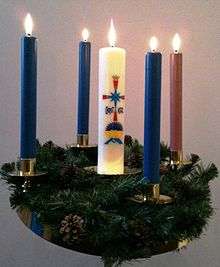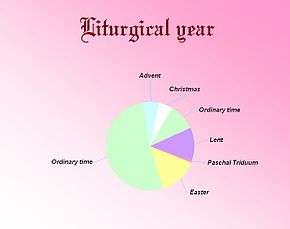Gaudete Sunday
| Gaudete Sunday | |
|---|---|
| Observed by | occident |
| Type | Christian |
| Observances | church services, candles, Advent hymns |
| Date | second-final Sunday before Christmas Day |
| 2015 date | 13 December |
| 2016 date | 11 December |
| 2017 date | 17 December |
| 2018 date | 16 December |
Gaudete Sunday (/ɡaʊˈdeɪteɪ/ gow-DAY-tay) is the third Sunday of Advent in the liturgical calendar of the Western Church, including the Roman Catholic Church, the Anglican Communion, many Lutheran Churches, and other mainline Protestant churches. It can fall on any date from 11 December to 17 December.
"Gaudete"

The day takes its common name from the Latin word Gaudete ("Rejoice"), the first word of the introit of this day's Mass:[1]
Gaudete in Domino semper: iterum dico, gaudete. Modestia vestra nota sit omnibus hominibus: Dominus enim prope est. Nihil solliciti sitis: sed in omni oratione et obsecratione cum gratiarum actione petitiones vestræ innotescant apud Deum. Benedixisti Domine terram tuam: avertisti captivitatem Jacob.
This may be translated as: "Rejoice in the Lord always; again I say, rejoice. Let your forbearance be known to all, for the Lord is near at hand; have no anxiety about anything, but in all things, by prayer and supplication, with thanksgiving, let your requests be known to God. Lord, you have blessed your land; you have turned away the captivity of Jacob." Philippians 4:4–6; Psalm 85 (84):1
.jpg)
Background
The season of Advent originated as a fast of forty days in preparation for Christmas, commencing on the day after the feast of St. Martin (11 November), whence it was often called "St. Martin's Lent"—a name by which it was known as early as the fifth century. In the ninth century, the duration of Advent was reduced to four weeks, and Advent preserved most of the characteristics of a penitential season which made it a kind of counterpart to Lent. Gaudete Sunday is a counterpart to Laetare Sunday, and provides a similar break about midway through a season which is otherwise of a penitential character, and signifies the nearness of the Lord's coming.[1]
The spirit of the Liturgy all through Advent is one of expectation and preparation for the feast of Christmas as well as for the second coming of Christ, and the penitential exercises suitable to that spirit are thus on Gaudete Sunday suspended, as were, for a while in order to symbolize that joy and gladness in the promised Redemption.[1]
Theme

While the theme of Advent is a focus on the coming of Jesus in three ways: His first, His present and His final Advent,[2] the readings for Gaudete Sunday deal with rejoicing in the Lord — Christian joy — as well as the mission of St. John the Baptist and his connection with Advent. Theologian Henri Nouwen described the difference between joy and happiness. While happiness is dependent on external conditions, joy is "the experience of knowing that you are unconditionally loved and that nothing -- sickness, failure, emotional distress, oppression, war, or even death -- can take that love away."[3] Thus joy can be present even in the midst of sadness.
In his 2014 Gaudete Sunday homily, Pope Francis said that Gaudete Sunday is known as the "Sunday of joy," and that instead of fretting about "all they still haven't" done to prepare for Christmas, people should "think of all the good things life has given you."[4]
Liturgical colour

On Gaudete Sunday rose-coloured vestments may be worn instead of violet (or instead of Sarum blue, in the Anglican and some Lutheran and other Protestant traditions), which is otherwise prescribed for every day in the season of Advent. Gaudete Sunday was also known as "Rose Sunday".[5]
In churches that have an Advent wreath, the rose coloured candle is lit in addition to two of the violet (or blue) coloured candles, which represent the first two Sundays of Advent. Despite the otherwise somber readings of the season of Advent, which has as a secondary theme the need for penitence, the readings on the third Sunday emphasize the joyous anticipation of the Lord's coming.
In the Anglican Church, the use of rose-pink, previously informally observed, was formally noted as an option in the Church of England in the Common Worship liturgical renewal.[6]
See also
- Laetare Sunday
- Advent Sunday
- Gaudete, a Christmas carol
References
- 1 2 3 Alston, George Cyprian. "Gaudete Sunday." The Catholic Encyclopedia. Vol. 6. New York: Robert Appleton Company, 1909. 13 Oct. 2013
- ↑ Rojas Jr., Roberto. "Gaudete Sunday: Breaking the Rules", Lutheran Witness, 10 December 2015
- ↑ Laskey, Mike Jordan. "This Gaudete Sunday, rejoice despite the heartbreak all around us", National Catholic Reporter, 11 December 2014
- ↑ "Pope celebrates Mass for Gaudete Sunday at Roman parish", Vatican Radio, 14 December 2014
- ↑ "Gaudete Sunday", The Episcopal Church
- ↑ The traditional use of rose-pink vestments on this day is suggested in the liturgical colour sequence notes of Common Worship of which an on-line version may be found here.
